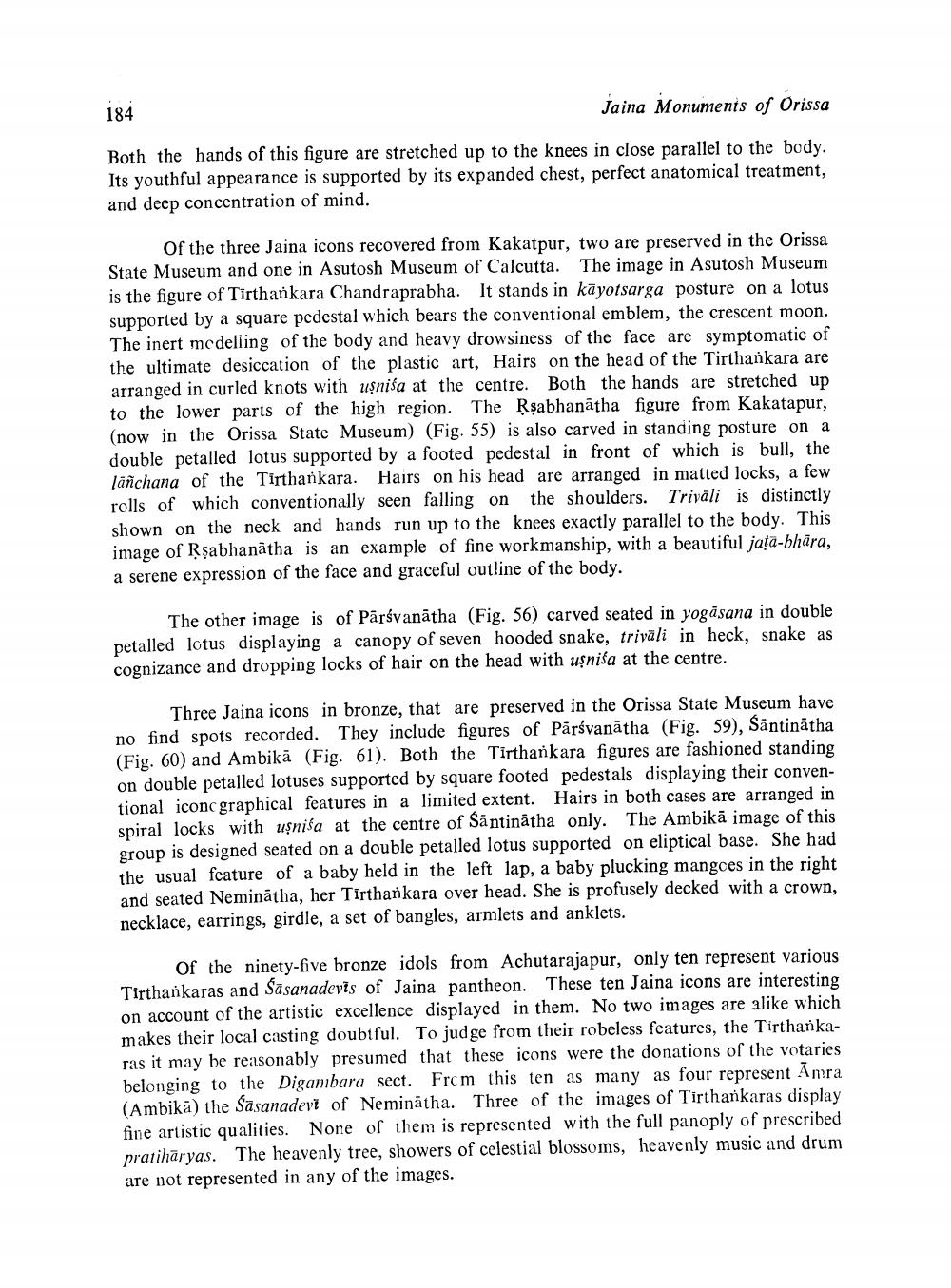________________
184
Jaina Monuments of Orissa Both the hands of this figure are stretched up to the knees in close parallel to the body. Its youthful appearance is supported by its expanded chest, perfect anatomical treatment, and deep concentration of mind.
Of the three Jaina icons recovered from Kakatpur, two are preserved in the Orissa State Museum and one in Asutosh Museum of Calcutta. The image in Asutosh Museum is the figure of Tirthankara Chandraprabha. It stands in kāyotsarga posture on a lotus supported by a square pedestal which bears the conventional emblem, the crescent moon. The inert modelling of the body and heavy drowsiness of the face are symptomatic of the ultimate desiccation of the plastic art, Hairs on the head of the Tirthankara are arranged in curled knots with uşnisa at the centre. Both the hands are stretched up to the lower parts of the high region. The Rşabhanātha figure from Kakatapur, (now in the Orissa State Museum) (Fig. 55) is also carved in standing posture on a double petalled lotus supported by a footed pedestal in front of which is bull, the lañchana of the Tirthankara. Hairs on his head are arranged in matted locks, a few rolls of which conventionally seen falling on the shoulders. Triväli is distinctly shown on the neck and hands run up to the knees exactly parallel to the body. This image of Rşabhanātha is an example of fine workmanship, with a beautiful jata-bhāra, a serene expression of the face and graceful outline of the body.
The other image is of Pārsvanātha (Fig. 56) carved seated in yogasana in double petalled lotus displaying a canopy of seven hooded snake, trivali in heck, snake as cognizance and dropping locks of hair on the head with uşnisa at the centre.
Three Jaina icons in bronze, that are preserved in the Orissa State Museum have no find spots recorded. They include figures of Pārśvanātha (Fig. 59), Säntinātha (Fig. 60) and Ambikā (Fig. 61). Both the Tirthankara figures are fashioned standing on double petalled lotuses supported by square footed pedestals displaying their conventional iconographical features in a limited extent. Hairs in both cases are arranged in spiral locks with uşnisa at the centre of Santinātha only. The Ambikā image of this group is designed seated on a double petalled lotus supported on eliptical base. She had the usual feature of a baby held in the left lap, a baby plucking mangoes in the right and seated Neminātha, her Tirthankara over head. She is profusely decked with a crown, necklace, earrings, girdle, a set of bangles, armlets and anklets.
of the ninety-five bronze idols from Achutarajapur, only ten represent various Tirthankaras and Sāsanadevis of Jaina pantheon. These ten Jaina icons are interesting on account of the artistic excellence displayed in them. No two images are alike which makes their local casting doubtful. To judge from their robeless features, the Tirthankaras it may be reasonably presumed that these icons were the donations of the votaries belonging to the Digambara sect. From this ten as many as four represent Anra (Ambikā) the Sasanadevă of Neminātha. Three of the images of Tirthankaras display fine artistic qualities. None of them is represented with the full panoply of prescribed pratihāryas. The heavenly tree, showers of celestial blossoms, heavenly music and drum are not represented in any of the images.




